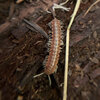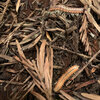Lufox
Arachnopeon
- Joined
- Nov 11, 2020
- Messages
- 3
After a couple months of putting it off I finally got around to collecting a group of Xystocheir dissecta for a breeding project. Subspecies hasn't been confirmed, but almost certainly Xystocheir dissecta subsp. dissecta. I hope to finally be able to see some success with this genus, I know someone who bred the alpine Xystocheir brachymacris so I hope to have success with this sea level species. These things are wildly fluorescent under UV light and can be easily found using UV at night. Supposedly after rain is better, but I haven't looked for them in the dry months so I can't comment but it would make sense.
I'm using the formula that worked for Motyxia and Xystocheir brachymacris, which is substrate harvested from the point of collection and also redwood duff. Given these are found almost exclusively in redwood groves their substrate is a mixture of heavily decomposed duff (and added calcium) with more lightly decomposed stuff topping it off with branches and other harder materials scattered throughout. I put a few chunks of wood in it as well. I added a few pieces of moss also, not necessarily because moss is found in the groves but rather for hydration purposes. After all, moss is found surrounding the groves so it's not like they're never exposed to it in nature.

These things are super tiny! Close to but definitely shorter then Harpaphe haydeniana.


Definitely some variation among individuals with the intensity of the dorsal stripe changing as well as the brightness+shade of the coloration on the segments. Some seem to have reduced pattern. This could be chalked up to maturity so we'll see what happens over time as the group ages.

All millipedes in the family Xystodesmidae lack eyes. Just a neat feature. I have observed that often these won't react when I open their bins, presumably due to the lack of sensory input due to not seeing the light change. With cylindricals a lack of reaction would often indicate a lethargic specimen which can be good or bad, but with these it's harder to tell.
These last two videos show how fluorescent they are, as well as what the setup looks like. Hopefully with some time and a bit of luck we'll see some babies!
View attachment IMG_2182.mp4
View attachment IMG_2183 (1).mp4
I'm using the formula that worked for Motyxia and Xystocheir brachymacris, which is substrate harvested from the point of collection and also redwood duff. Given these are found almost exclusively in redwood groves their substrate is a mixture of heavily decomposed duff (and added calcium) with more lightly decomposed stuff topping it off with branches and other harder materials scattered throughout. I put a few chunks of wood in it as well. I added a few pieces of moss also, not necessarily because moss is found in the groves but rather for hydration purposes. After all, moss is found surrounding the groves so it's not like they're never exposed to it in nature.

These things are super tiny! Close to but definitely shorter then Harpaphe haydeniana.


Definitely some variation among individuals with the intensity of the dorsal stripe changing as well as the brightness+shade of the coloration on the segments. Some seem to have reduced pattern. This could be chalked up to maturity so we'll see what happens over time as the group ages.

All millipedes in the family Xystodesmidae lack eyes. Just a neat feature. I have observed that often these won't react when I open their bins, presumably due to the lack of sensory input due to not seeing the light change. With cylindricals a lack of reaction would often indicate a lethargic specimen which can be good or bad, but with these it's harder to tell.
These last two videos show how fluorescent they are, as well as what the setup looks like. Hopefully with some time and a bit of luck we'll see some babies!
View attachment IMG_2182.mp4
View attachment IMG_2183 (1).mp4
Last edited:


